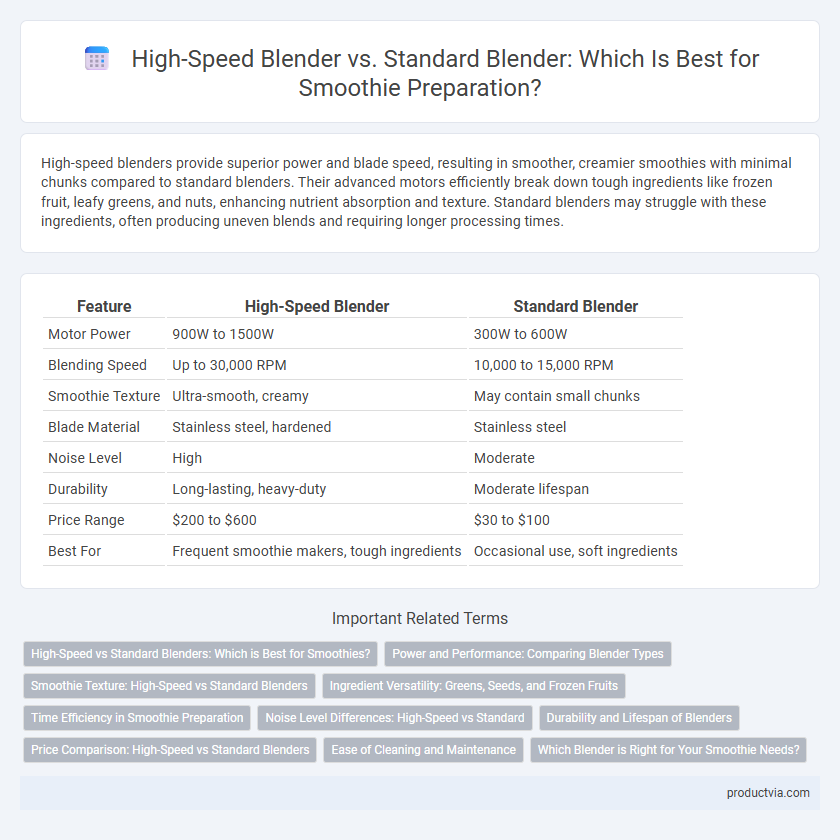High-speed blenders provide superior power and blade speed, resulting in smoother, creamier smoothies with minimal chunks compared to standard blenders. Their advanced motors efficiently break down tough ingredients like frozen fruit, leafy greens, and nuts, enhancing nutrient absorption and texture. Standard blenders may struggle with these ingredients, often producing uneven blends and requiring longer processing times.
Table of Comparison
| Feature | High-Speed Blender | Standard Blender |
|---|---|---|
| Motor Power | 900W to 1500W | 300W to 600W |
| Blending Speed | Up to 30,000 RPM | 10,000 to 15,000 RPM |
| Smoothie Texture | Ultra-smooth, creamy | May contain small chunks |
| Blade Material | Stainless steel, hardened | Stainless steel |
| Noise Level | High | Moderate |
| Durability | Long-lasting, heavy-duty | Moderate lifespan |
| Price Range | $200 to $600 | $30 to $100 |
| Best For | Frequent smoothie makers, tough ingredients | Occasional use, soft ingredients |
High-Speed vs Standard Blenders: Which is Best for Smoothies?
High-speed blenders deliver superior performance in smoothie preparation due to their powerful motors and advanced blade design, ensuring smoother textures and better nutrient extraction. Standard blenders often struggle with frozen fruits and tough ingredients, resulting in less consistent blends and longer processing times. Investing in a high-speed blender enhances smoothie quality, making it the preferred choice for frequent users seeking efficiency and optimal taste.
Power and Performance: Comparing Blender Types
High-speed blenders typically operate at 1000 to 1500 watts, offering superior power to crush ice and blend fibrous fruits efficiently, which results in smoother, creamier smoothies. Standard blenders usually range from 300 to 700 watts, making them less effective at breaking down tough ingredients and producing consistent textures. The enhanced motor strength and blade design of high-speed blenders significantly improve performance, reducing blending time and ensuring nutrient retention in smoothie preparation.
Smoothie Texture: High-Speed vs Standard Blenders
High-speed blenders create a smoother, creamier texture by pulverizing fruits and ice into a fine consistency, whereas standard blenders often produce a chunkier blend with occasional ice shards. The powerful motor and sharp blades of high-speed blenders break down fibrous ingredients more effectively, enhancing the smoothie's mouthfeel. Choosing a high-speed blender ensures a velvety texture that standard blenders typically cannot achieve in smoothie preparation.
Ingredient Versatility: Greens, Seeds, and Frozen Fruits
High-speed blenders offer superior ingredient versatility for smoothie preparation by effortlessly pulverizing tough greens, seeds, and frozen fruits into a smooth, creamy texture. Standard blenders often struggle with fibrous vegetables and hard seeds, resulting in a less consistent blend. The powerful motor and sharp blades of high-speed blenders ensure efficient nutrient extraction and smoother mixtures, enhancing both flavor and texture.
Time Efficiency in Smoothie Preparation
High-speed blenders significantly reduce smoothie preparation time by efficiently pulverizing tough ingredients like frozen fruits and leafy greens within seconds, unlike standard blenders that require longer blending cycles. Their powerful motors and sharp blades create smoother textures faster, ensuring consistent results without repeated blending. Time efficiency in smoothie preparation is maximized with high-speed blenders, making them ideal for quick, healthy beverage creation.
Noise Level Differences: High-Speed vs Standard
High-speed blenders typically produce significantly more noise due to powerful motors designed for rapid blade rotation, often exceeding 90 decibels, while standard blenders operate at lower speeds generating noise levels around 70-80 decibels. The increased noise in high-speed blenders can impact indoor use, especially in quiet environments, making standard blenders more suitable for noise-sensitive settings. Noise level differences are influenced by motor power, blade design, and housing insulation, with high-speed blenders prioritizing performance over noise reduction.
Durability and Lifespan of Blenders
High-speed blenders typically feature robust motor components and high-quality materials designed to withstand frequent use, resulting in greater durability compared to standard blenders. The enhanced motor power reduces strain during blending, extending the appliance's lifespan significantly in smoothie preparation. Standard blenders often have less durable blades and motors that wear down faster, making them less reliable for frequent, intensive blending tasks.
Price Comparison: High-Speed vs Standard Blenders
High-speed blenders typically range from $200 to $600, offering powerful motors and advanced features ideal for smooth and consistent smoothie textures. Standard blenders are more affordable, usually priced between $30 and $100, but may lack the torque needed for fully breaking down fibrous ingredients. Investing in a high-speed blender ensures efficiency and durability, while standard blenders provide a budget-friendly option for basic smoothie preparation.
Ease of Cleaning and Maintenance
High-speed blenders feature detachable blades and self-cleaning modes that significantly reduce cleaning time compared to standard blenders. Their high-powered motors are designed to minimize residue build-up, facilitating easier maintenance for frequent smoothie preparation. Standard blenders often require manual disassembly and scrubbing, making them less convenient for users prioritizing effortless upkeep.
Which Blender is Right for Your Smoothie Needs?
High-speed blenders feature powerful motors exceeding 1,000 watts, effortlessly pulverizing frozen fruits and leafy greens into silky smooth textures ideal for nutrient-rich smoothies. Standard blenders, with motors typically under 600 watts, handle basic blending tasks but may struggle with ice or fibrous ingredients, resulting in chunkier consistency. Choosing the right blender depends on smoothie frequency and ingredient diversity; high-speed models offer versatility and efficiency for daily smoothie enthusiasts, while standard blenders suffice for occasional, simpler blends.
High-speed blender vs standard blender for smoothie preparation Infographic

 productvia.com
productvia.com